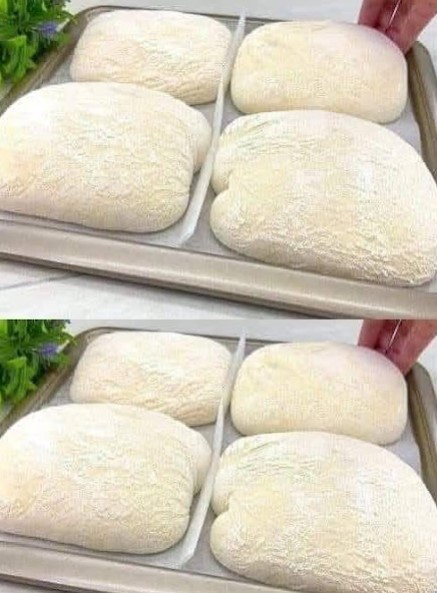Ciabatta is a traditional Italian bread known for its rustic appearance, chewy crust, and airy crumb. It’s perfect for sandwiches, dipping in olive oil, or enjoying on its own. Here’s a basic recipe to make ciabatta bread at home
Table of Contents

Ingredients
For the Biga (starter):
- 1 1/2 cups (180g) all-purpose flour
- 1/4 teaspoon active dry yeast
- 1/2 cup (120ml) water, at room temperature
For the Dough:
- 2 cups (240g) all-purpose flour
- 1 teaspoon salt
- 1 teaspoon sugar
- 3/4 teaspoon active dry yeast
- 3/4 cup (180ml) water, lukewarm
- 2 tablespoons olive oil
Instructions
1. Prepare the Biga:
- Combine the flour, yeast, and water in a bowl until smooth.
- Cover the bowl with plastic wrap and let it sit at room temperature for 12-16 hours. This develops flavor and creates the base for the ciabatta.
2. Make the Dough:
- In a mixing bowl, combine flour, salt, sugar, and yeast.
- Add the biga, water, and olive oil. Mix until the dough is shaggy.
- Knead the dough on a floured surface or with a stand mixer for about 8-10 minutes until smooth and elastic. The dough will be sticky; avoid adding too much flour.
3. First Rise:
- Place the dough in a lightly oiled bowl and cover with a damp towel or plastic wrap.
- Let it rise for 1-2 hours, or until doubled in size.
4. Shape the Dough:
- Turn the dough onto a floured surface. Divide it into two pieces.
- Gently shape each piece into a rectangular loaf without deflating it.
- Transfer the loaves to a baking sheet lined with parchment paper.
5. Second Rise:
- Cover the loaves loosely and let them rise for 45 minutes to 1 hour, until puffy.
6. Bake the Ciabatta:
- Preheat the oven to 450°F (230°C). Place an empty baking pan on the bottom rack.
- Before baking, pour a cup of hot water into the empty pan to create steam.
- Bake the loaves for 20-25 minutes, or until golden brown and hollow-sounding when tapped.
More About Ciabatta
- Origin:
- Ciabatta was invented in 1982 in Verona, Italy, by Arnaldo Cavallari. It was created as Italy’s answer to the popular French baguette.
- Name Meaning:
- “Ciabatta” means “slipper” in Italian, named for its flat, elongated shape.
- Texture:
- The hallmark of ciabatta is its open, airy crumb with large irregular holes, achieved by a high hydration dough and gentle handling.
Serving Ideas
- Sandwiches:
- Use ciabatta for hearty sandwiches with fillings like roasted vegetables, cured meats, cheeses, or grilled chicken.
- Panini:
- Press ciabatta in a panini press with ingredients like mozzarella, tomato, and basil for a classic Italian panini.
- Soup Companion:
- Serve slices of ciabatta alongside soups or stews to soak up flavors.
- Bruschetta or Crostini:
- Toast slices of ciabatta and top them with garlic, olive oil, tomatoes, or spreads.
- Dipping Bread:
- Dip pieces of ciabatta in olive oil with balsamic vinegar, or serve it with hummus or herbed butter.
Variations
- Whole Wheat Ciabatta:
- Substitute part of the all-purpose flour with whole wheat flour for a nuttier flavor and added nutrients.
- Herbed Ciabatta:
- Add chopped rosemary, thyme, or other herbs to the dough for a fragrant twist.
- Olive Ciabatta:
- Incorporate chopped olives (black or green) into the dough for a savory, Mediterranean flavor.
- Cheesy Ciabatta:
- Sprinkle grated Parmesan or Asiago on top before baking for a cheesy crust.
- Ciabatta Rolls:
- Instead of loaves, shape the dough into smaller rolls, perfect for individual servings or sliders.
Tips for Perfect Ciabatta
- Hydration:
- The dough should be wet and sticky; this ensures the classic airy structure. Resist the urge to add too much flour.
- Stretch and Fold:
- Instead of vigorous kneading, try the stretch-and-fold method during the first rise. This technique strengthens the dough while keeping it light.
- Steam in the Oven:
- Steam helps develop the crust. You can also spritz the dough with water before placing it in the oven.
- Avoid Overhandling:
- Be gentle when shaping the dough to preserve the air bubbles.
- Patience:
- Good ciabatta takes time. Let the dough rest and rise fully for the best results.
Interesting Pairings
- Pair ciabatta with Italian wines like Chianti or Pinot Grigio.
- Serve with spreads like artichoke dip, tapenade, or roasted red pepper hummus.
- Use ciabatta to make panzanella, a Tuscan bread salad with tomatoes, cucumbers, and vinaigrette.
Ciabatta bread is not just a recipe; it’s an invitation to experiment with flavors and textures while bringing a touch of Italian tradition to your table!